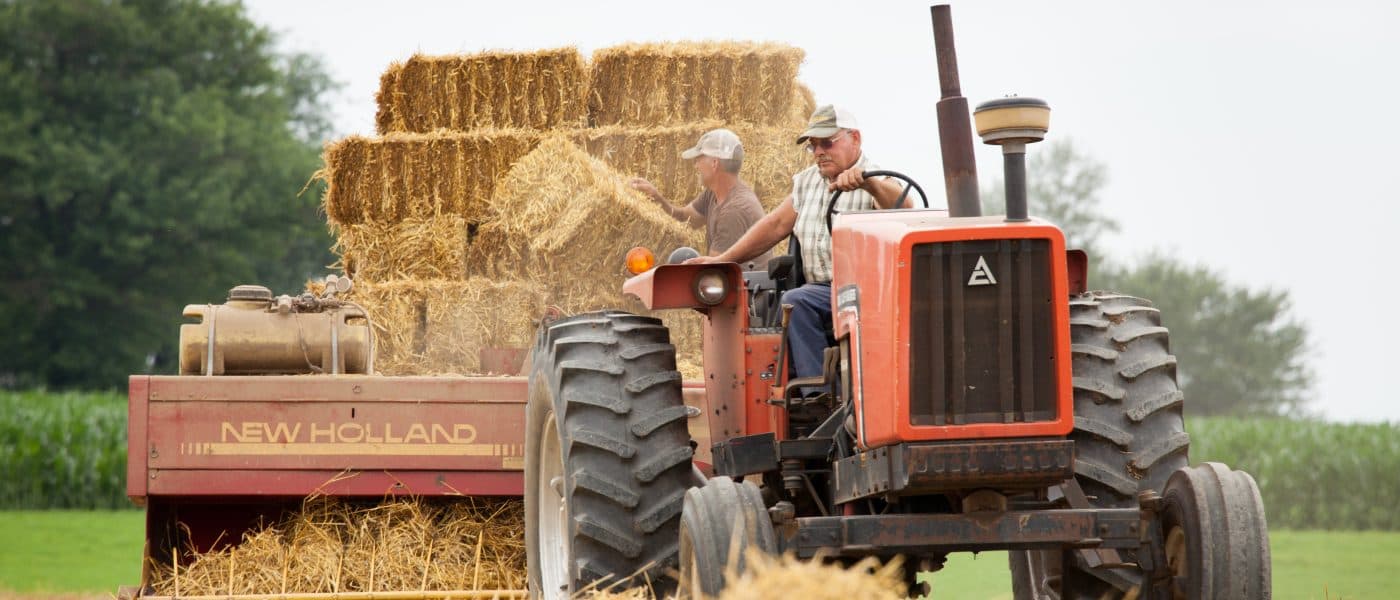The Farm Bill is a huge, complex piece of legislation (as our Farm Bill 101 makes clear) and its path through Congress will be filled with twists and turns. We’re closely following this journey, looking at how the proposed bills in the House and Senate will impact farmers, eaters, and residents of rural communities. Over the coming months, Farm Aid will keep this post updated with the latest news on the Farm Bill and opportunities to speak up to improve it.
Agriculture appropriations process begins again while future of farm bill remains uncertain
June 13, 2024
On Monday, June 11, the House Appropriations Committee released their proposed funding bill for the 2025 fiscal year. Appropriations bills are passed annually and determine how much funding different parts of the federal government receive. The Agriculture Appropriations bill determines how much funding USDA and important agriculture programs receive. Disappointingly, the House’s proposed funding bill makes spending cuts – cutting total funding by 3.6% from 2024 – to every Farm Aid priority program, cuts SNAP funding and includes very harmful “riders” (unrelated policies tacked onto a spending bill.) Among these riders are measures to eliminate protections for small meat and poultry producers against large companies, prohibit equity, diversity and inclusion programs at the USDA, and allows individuals and organizations to discriminate against LGBTQIA+ people on the basis of “sincerely held religious beliefs.” The proposed bill passed along party lines over the course of a very quick 30-minute vote. The bill will be brought to the whole House for a vote in July.
Meanwhile, on June 12, Republicans on the Senate Agriculture Committee released a very general framework for their version of a Senate farm bill. The summary lacks any specific funding details and is a very high-level overview, but at first glance appears to be very similar to the House’s Farm, Food, and National Security Act of 2024 (otherwise known as the farm bill) that passed in May. The move could signal that there is momentum building in the Senate around an effort to pass a farm bill before the end of the year.
May 29, 2024
House Agriculture Committee passes farm bill markup
After more than thirteen hours of “mark-up” on Thursday, May 23rd, the House Agriculture Committee passed the Farm, Food, and National Security Act of 2024 (HR 8467) – their version of the farm bill. The bill passed with 33 votes for and 21 against, with four Democratic members of Congress, Representatives Caraveo (D-CO), Sorensen (D-IL), Davis (D-NC) and Bishop (D-GA), joining with Republicans in favor.
Over 50 amendments to the draft were proposed and considered during the mark-up process. Notably, Democrats had proposed amendments that would restore mandatory climate mitigation requirements to Inflation Reduction Act funding and establish funding for climate-smart practices within conservation programs; nullify the cost-neutrality provision on the Thrifty Food Plan (a cost-cutting measure that would negatively impact SNAP funding); and would strike the restrictions on using Commodity Credit Corporation (CCC) funds, allowing USDA to respond to unexpected agricultural events and emerging issues. These amendments all failed to be included in the final bill text in votes that fell along party lines. One amendment, filed by Congressman Greg Cesar (D-TX), would have required USDA to stop contracting with meatpackers that use illegal child labor, but was rejected by Republicans who voted to initiate a government study on child labor instead.
Some notable amendments and policy changes made it into the final bill text; this legislation would raise reference prices, increase sustainable aviation fuel strategy, and weaken pesticide regulations. Commodity crops — peanuts rice, wheat, and cotton — receive the highest subsidy increases under the House’s farm bill.
Though the passage of the markup means that the House version of the farm bill is now ready to be voted on by the whole House, lots of uncertainty remains over when the bill will actually be brought to the floor.
HR 8467 marks the first meaningful step in passing the next farm bill, even though the process began more than a year ago. While this bill is deeply flawed, it’s an important jumping off point from which to begin the next phase of farm bill negotiations. The next step will be for the Senate Agriculture Committee to release its version of a farm bill and to follow the same mark-up and committee voting process. Stay tuned for more updates!
May 22, 2024
House Agriculture Committee releases disappointing and partisan 2024 Farm Bill draft
On Friday, May 17th, the House Agriculture Committee released its “mark,” or draft, of the 2024 Farm Bill. The nearly 1,000-page draft contained very few of Farm Aid’s priorities. By far, the bill reflected the interests of large scale industrial producers instead of helping to level the playing field for and supporting small and mid-size farmers.
The bill crosses several “red lines,” including removing climate change mitigation requirements from Inflation Reduction Act funding and cutting SNAP benefits. From the very beginning of Farm Bill conversations, Democrats have said these two issues are non-starters and they will not support a farm bill that includes these attempts to defund climate change efforts and curb nutrition programs.
Rather than increasing access to credit and crop insurance for small-scale operations and farmers working in diverse systems, the bill doubles down on support for large scale, industrial commodity operations – a group who already disproportionately benefits from agricultural subsidies. Additionally, the bill chooses to focus on funding precision agriculture technology over proven, farmer-led conservation practices. The bill also restricts the USDA’s ability to utilize the Commodity Credit Corporation, limiting its ability respond to emerging agricultural issues. While Republicans’ aim is to reduce spending in the Farm Bill, a budget score has not been conducted that measures how the bill will pay for its subsidies, making this draft difficult to fully assess.
The House Agriculture Committee will “mark-up,” or edit the bill on Thursday, May 23rd and vote on whether it will pass out of the committee to be voted on by the whole House. Currently, the Senate Agriculture Committee has not indicated when it will release its own draft of the farm bill.
Stay tuned for ways you can get involved in the Farm Bill process and for updates as they arise!
May 3, 2024
House and Senate release 2024 Farm Bill proposal summaries
In a surprise to many, the House and Senate agriculture committees released summaries of their respective farm bill proposals this week, indicating that we may see full farm bill drafts from both chambers imminently and potentially some new progress towards passing the 2024 Farm Bill.
These summaries are akin to getting a “sneak peak” into what a 2024 Farm Bill might look like; based on its summary, we can probably expect a largely bipartisan bill from the Senate that aligns with many of Farm Aid’s values, including preserving IRA climate funding and improving the farm safety net. Meanwhile, the House Agriculture Committee’s summary indicates a very different and much more partisan bill.
The contents of neither bill is certain, however, until full drafts are released. The timeline for the release of House and Senate farm bill drafts is still unknown.
March 11, 2024
USDA Appropriations is Complete! Farm Bill Still Unknown
YAY: Over the weekend, President Biden signed into law a $460 billion appropriations bill with funding through Sept. 30 for the USDA and five other federal departments. The bill finally provides full-year funding after four stopgap bills. Funding for the rest of the federal government depends on members of the House and Senate meeting the next deadline of March 22.
While Congress struggles to agree on how to fund the rest of the federal government more than five months into the fiscal year, President Biden today unveiled his proposed budget for Fiscal Year 2025. His proposal includes a significant increase in Agriculture Department funding—an increase of 7.4% from the 2023 level. Alas, the President’s budget is largely symbolic, setting forth the values and priorities of his administration. It is Congress who will ultimately decide the 2025 budget—hopefully without the delay that continues to plague the 2024 budget.
NAY: Unfortunately, there is no such movement on the Farm Bill. Congress is as divisive as ever and some members have expressed uncertainty that a new reauthorization could pass this year. While President Biden touted the value of agriculture in last week’s State of the Union address, he did not explicitly call on Congress to pass the Farm Bill, disappointing many.
February 22, 2024
Appropriations drag, Farm Bill progress lags
Since passing yet another set of continuing resolutions that keep the government funded through March 1st, Congress has kept dragging out the appropriations process. At this point, the passage of appropriations bills has taken so long that they’re starting to butt up against 2025 fiscal year budget-setting. What’s the hold-up? Spending levels are largely ironed out, so it’s the inclusion of policy riders, like the harmful rider that House Republicans and special interests included on the House FY 2024 Agriculture and FDA bill, that remain the primary hurdles. Failure to find agreement by March 1st will either force a partial government shutdown or necessitate yet another continuing resolution.
Once again, the dragging out of appropriations is leaving little room for Farm Bill progress and is shortening the window for action in March. Coupled with a very tight congressional calendar – Congress is in session March 11th through June 28th before summer break – there’s effectively only a late-spring window of several weeks to bring to the floor, debate, and pass the next Farm Bill. Though much of the Farm Bill is currently drafted, it is far from finished and money is the main barrier in continued progress. Namely, Republicans and Democrats are dug in on their respective priorities: commodity programs versus Inflation Reduction Act funding and nutrition programs. Policy experts guess that if Congress doesn’t pass a Farm Bill before the end of June, we’ll likely see it kicked down the road until after the 2024 elections.
January 9, 2024
New year, same problems?
Congress is back in session for the new year, facing the same challenges they left before heading on break in December. Namely, a partial government shutdown could happen as of January 20th if the House and Senate can’t agree on spending for the 2024 fiscal year.
As of January 7th, congressional leaders had agreed on an overall budget for funding the government; now they must write the legislation required to fund different government agencies, including the USDA. If Congress can’t agree on these individual appropriations packages and instead choose to pass a continuing resolution, as happened in November, many government agencies will see funding cuts.
Democratic leadership has indicated that it will stand fast in opposing any harmful policy riders, while far-right GOP members expressed outrage at the topline budget agreement, meaning that negotiations will continue to be fraught. Congress has less than two weeks to pass four appropriations bills. As these budget negotiations continue, progress on the next farm bill remains stagnant, with a best-case scenario for the bill’s introduction in March.
November 16, 2023
Congress passes Farm Bill extension
On November 15th, the Senate voted to pass a House bill for a continuing resolution, which included an extension of the 2018 Farm Bill. The bill extends the farm bill through September 2024. President Biden is expected to sign the bill into law.
This bill not only averts a government shutdown, but also includes funding for almost all “orphan” programs that would have otherwise lost funding as of January 1st. The extension gives Congress an additional 10 months to pass a new farm bill. Despite this longer runway, there is still lots to be negotiated. Legislators still need to decide how IRA funding will be distributed as well as funding for the Supplemental Nutrition Assistance Program (SNAP), two extremely contentious issues. It’s expected that Congress will use this extension to present a draft of a new farm bill early next year.
November 14, 2023
Congress poised to extend 2018 Farm Bill
The 2018 farm bill expired on September 30th, meaning as of October 1st, many programs lost funding and/or legal authorization to operate. The full effects of the expired bill will be felt on January 1st, 2024 unless an extension or new legislation is passed. Between a dragged out appropriations process and a prolonged struggle to determine House leadership, Congress has had little time to make headway on the next farm bill.
In October, Senate Ag Chair Debbie Stabenow publicly called for Congress to extend the current farm bill, rather than passing a new one. However, House Ag Chair G.T. Thompson expressed caution around if, and how, the farm bill should be extended. But an extension may be Congress’s best choice, given the unresolved appropriations process and a potential government shutdown on November 17th.
On November 11th, House Speaker Mike Johnson revealed a plan to introduce a stopgap measure that would avert a government shutdown and extend the current farm bill through September 2024. Crucially, this plan was conceived in part by House and Senate Agriculture Committee leaders, who included funding for the 20 programs “orphaned” when the 2018 Farm Bill expired.
This plan is far from a done deal, however, as some GOP members oppose the stopgap measure and may try to leverage the farm bill, and especially SNAP funding, as part of larger government shutdown negotiation.
July 18, 2023
Congress heads into last session before August recess
On June 22nd, the Senate Agriculture Appropriations Committee approved the fiscal year 2024 agriculture appropriations bill, unanimously and with bipartisan approval. Compared to the House Appropriations Committee bill passed the week prior, this bill did not contain the same deep cuts to spending on research, nutrition, and other important programs. It also did not include the same rider that limited the Packers and Stockyards Act as the House Appropriations bill.
The Senate bill set spending at $500 million more than last year, with increases primarily to the Special Supplemental Nutrition Program for Women, Infants, and Children (WIC) program. The next step is for the two chambers of Congress to reconcile, or come to an agreement between the two bills, a process that will likely prove difficult given the vast differences between them and the control that far right Republicans have on the House.
Congress resumes their work this week, which will be their last session before August recess. This will be a final opportunity for legislators to introduce “marker bills,” bills that are not intended to pass, but that allow legislators to put forward their priorities within the Farm Bill and get a feel for their support.
Congress will likely put forward a first draft of the 2023 Farm Bill when they are back in September. Stay tuned for more updates!
May 18, 2023
Bill with drastic cuts moves forward
The House Agriculture Appropriations Subcommittee passed an agriculture appropriations bill. We were disappointed to see that it drastically cut agricultural funding by 30% ($8.3 billion) for the 2024 fiscal year budget as compared to 2023. This bill passed out of subcommittee along party lines. Next up, the House Appropriations Committee will markup the bill. This step was supposed to occur the week of May 22, but has been delayed due to ongoing debt ceiling negotiations.



